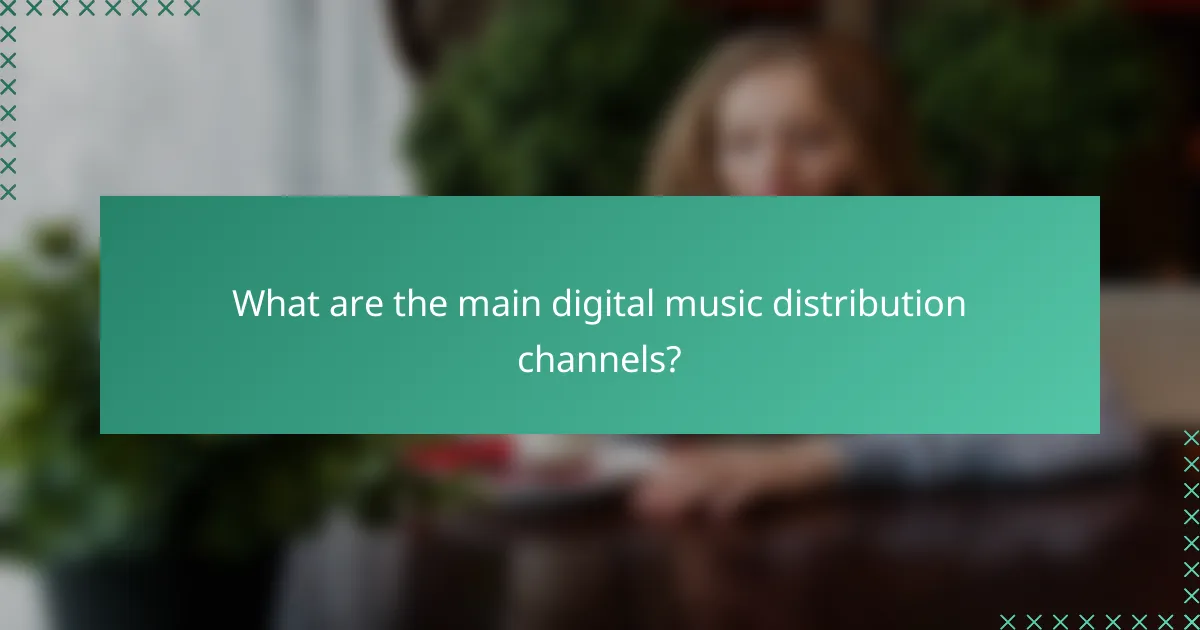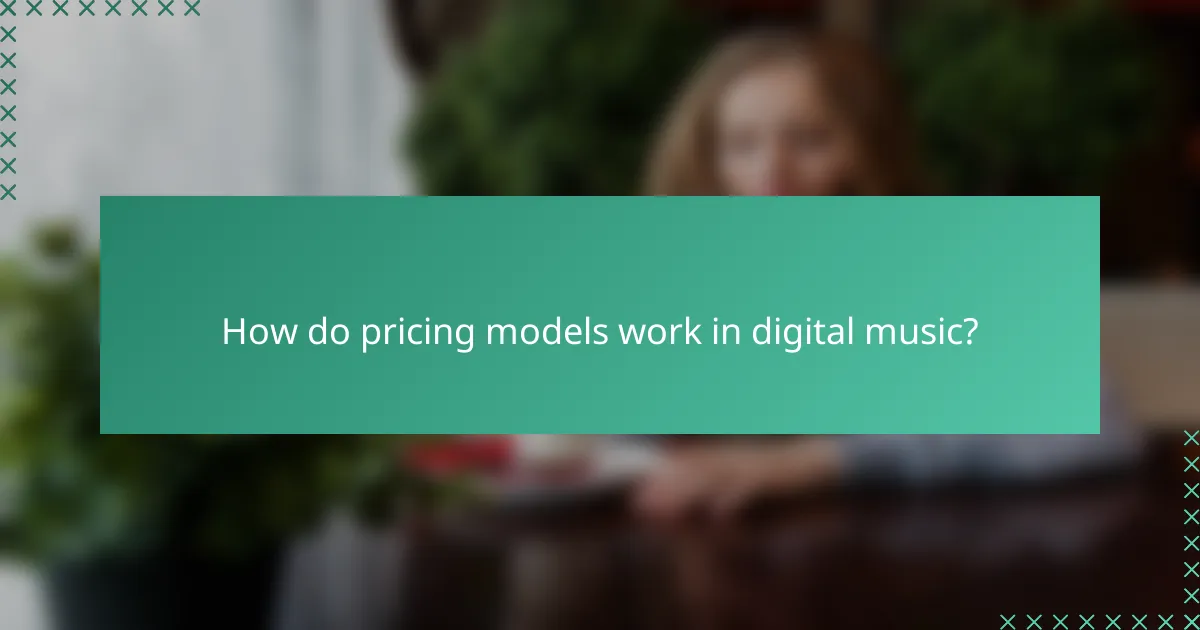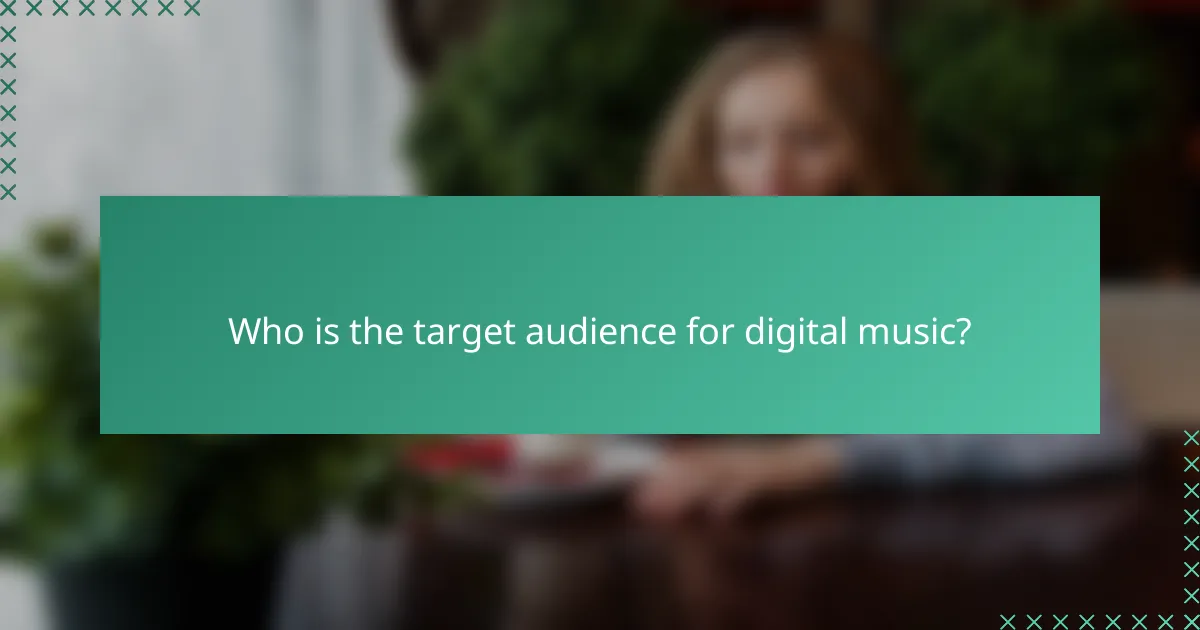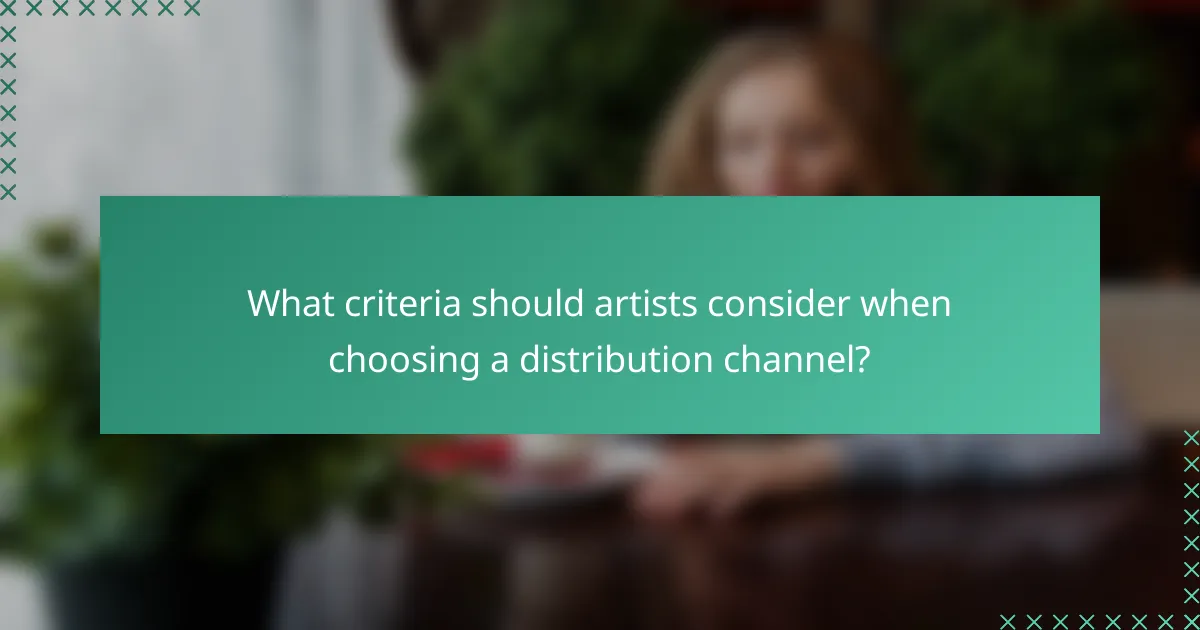Digital music distribution has evolved to include various channels such as streaming platforms, digital download stores, and social media, each catering to distinct audience preferences. The choice of distribution channel is crucial for artists, as it influences their reach and engagement with listeners. Additionally, pricing models play a significant role in monetizing music, impacting revenue generation and audience interaction. Understanding the target audience, primarily young adults and music enthusiasts, is essential for effective marketing and distribution strategies.

What are the main digital music distribution channels?
The primary digital music distribution channels include streaming platforms, digital download stores, direct-to-fan platforms, and social media channels. Each channel offers unique advantages and caters to different audience preferences, making it essential for artists to choose the right mix for their music distribution strategy.
Streaming platforms like Spotify
Streaming platforms such as Spotify dominate the digital music landscape by allowing users to listen to music on-demand without purchasing individual tracks. Artists typically earn revenue through a combination of subscription fees and advertising, with payouts often based on the number of streams.
To maximize exposure on these platforms, artists should focus on creating engaging playlists, collaborating with other musicians, and utilizing promotional tools offered by the platforms. Regularly releasing new content can also help maintain listener interest and boost streaming numbers.
Digital download stores such as iTunes
Digital download stores like iTunes allow consumers to purchase and own individual tracks or entire albums. This model appeals to listeners who prefer to have permanent access to their music, often resulting in higher per-track revenue for artists compared to streaming.
When distributing music through download stores, artists should consider pricing strategies, such as offering discounts for album purchases or bundling tracks. It’s also beneficial to ensure high-quality audio files and engaging artwork to attract potential buyers.
Direct-to-fan platforms like Bandcamp
Direct-to-fan platforms such as Bandcamp enable artists to sell their music directly to fans, often allowing for greater control over pricing and revenue. This model fosters a closer connection between artists and their audience, as fans can support musicians directly.
Artists using these platforms should leverage features like merchandise sales, exclusive content, and subscription models to enhance their offerings. Engaging with fans through updates and personalized messages can further strengthen this relationship and encourage repeat purchases.
Social media channels for music promotion
Social media channels play a crucial role in promoting music and engaging with audiences. Platforms like Instagram, TikTok, and Facebook allow artists to share snippets of their work, behind-the-scenes content, and interact directly with fans, creating a vibrant community around their music.
To effectively promote music on social media, artists should maintain a consistent posting schedule, use relevant hashtags, and collaborate with influencers or other musicians. Running targeted ad campaigns can also help reach new listeners and drive traffic to their music on streaming or download platforms.

How do pricing models work in digital music?
Pricing models in digital music determine how artists and platforms monetize music distribution. These models can significantly impact revenue generation and audience engagement, with various options available to suit different market needs.
Subscription-based pricing
Subscription-based pricing allows users to pay a recurring fee for access to a library of music. This model typically offers unlimited streaming and may include offline listening options, appealing to avid music listeners.
Popular platforms like Spotify and Apple Music charge monthly fees ranging from around $5 to $15, depending on the plan. Artists receive a share of the subscription revenue, which can vary based on factors like listener engagement and the platform’s payout structure.
Pay-per-download pricing
Pay-per-download pricing requires users to purchase individual tracks or albums, providing a straightforward revenue model for artists. This approach allows consumers to own their music outright, which can be appealing for collectors.
Prices for downloads typically range from $0.99 to $1.29 per song, with albums often priced between $9.99 and $14.99. While this model can generate higher revenue per transaction, it may limit overall sales volume compared to subscription services.
Freemium models with ads
Freemium models offer users free access to music with advertisements, while also providing an option to upgrade to an ad-free experience through a subscription. This approach can attract a larger audience and convert some users into paying customers over time.
Platforms like YouTube Music and SoundCloud utilize this model, balancing ad revenue with subscription income. While this can maximize user engagement, artists may earn less per stream compared to paid models, making listener conversion crucial for revenue growth.

Who is the target audience for digital music?
The target audience for digital music primarily includes young adults, music enthusiasts, and independent artists. Understanding these groups helps in tailoring marketing strategies and distribution channels effectively.
Young adults aged 18-34
This demographic is the largest consumer of digital music, often seeking convenience and accessibility. They prefer streaming services like Spotify and Apple Music, which offer vast libraries and personalized playlists.
Young adults typically engage with music through mobile devices, making it essential for artists and labels to optimize their content for smartphones and tablets. Social media platforms also play a crucial role in music discovery for this age group.
Music enthusiasts and collectors
Music enthusiasts are deeply passionate about their favorite genres and artists, often seeking high-quality audio and exclusive content. They may prefer purchasing digital albums or high-resolution tracks from platforms like Bandcamp or Beatport.
This audience values limited editions, remixes, and behind-the-scenes content, making it beneficial for artists to offer unique experiences or merchandise. Engaging with this group through newsletters or fan clubs can enhance loyalty and sales.
Independent artists and labels
Independent artists and labels target niche audiences and often rely on digital platforms for distribution. They utilize services like DistroKid or TuneCore to release music across various streaming platforms without the backing of major labels.
Building a direct connection with fans through social media and email marketing is vital for independent artists. They should focus on creating authentic content and engaging with their audience to foster a loyal fanbase.

What are the benefits of using streaming platforms?
Streaming platforms offer artists and labels a modern way to distribute music, reaching vast audiences while generating revenue through various models. These platforms simplify access for listeners and provide valuable data insights for creators.
Wider audience reach
Streaming platforms enable artists to connect with millions of listeners globally, breaking geographical barriers that traditional distribution methods often impose. This broad access allows for diverse fan bases, as users can discover new music from different cultures and genres.
For example, a musician in the United States can easily reach fans in Europe or Asia without the need for physical distribution. This increased visibility can lead to more concert opportunities and merchandise sales, enhancing overall career growth.
Higher revenue potential through subscriptions
Streaming services typically operate on subscription models, allowing users to pay a monthly fee for ad-free access to a vast library of music. This model can generate higher revenue for artists compared to traditional sales, especially as consumers increasingly prefer access over ownership.
Platforms like Spotify and Apple Music distribute a portion of subscription fees to artists based on streaming numbers, which can accumulate significantly over time. Artists should consider promoting their music on these platforms to maximize their earnings potential, especially as subscription services continue to grow in popularity.

What criteria should artists consider when choosing a distribution channel?
Artists should consider factors such as target audience alignment, revenue share models, and the overall reach of the distribution channel when selecting a platform. Each of these criteria can significantly impact an artist’s visibility and profitability in the digital music landscape.
Target audience alignment
Understanding the target audience is crucial for artists when choosing a distribution channel. Different platforms cater to various demographics; for instance, Spotify tends to attract younger listeners, while services like Apple Music may appeal to a broader age range. Artists should analyze where their potential fans are most active to maximize engagement and listenership.
Additionally, artists should consider the genre of their music. Niche platforms may serve specific genres better than mainstream services, allowing for a more dedicated audience. Researching user demographics and platform popularity can help artists make informed decisions.
Revenue share models
Revenue share models vary significantly across distribution channels, impacting how much artists earn per stream or sale. Most platforms operate on a percentage basis, where artists receive a portion of the revenue generated from their music. For example, some services may offer artists around 70% of the revenue, while others might provide only 50% or less.
Artists should carefully review the terms and conditions of each platform to understand the financial implications. It’s also beneficial to consider additional costs, such as distribution fees or promotional expenses, which can affect overall earnings. A clear understanding of these models will help artists choose a channel that aligns with their financial goals.

What are the emerging trends in digital music distribution?
Emerging trends in digital music distribution include the integration of blockchain technology and the rise of niche streaming services. These developments are reshaping how artists reach audiences and monetize their work.
Increased use of blockchain technology
Blockchain technology is gaining traction in digital music distribution by providing transparent and secure transactions. It allows artists to receive direct payments from listeners, reducing reliance on traditional intermediaries like record labels and streaming platforms.
This technology can also help ensure that copyright and ownership rights are clearly defined and enforced. For example, smart contracts can automate royalty payments, ensuring artists are compensated fairly and promptly.
Growth of niche streaming services
Niche streaming services are emerging as alternatives to mainstream platforms, catering to specific genres or audiences. These services often focus on curated content, offering a more personalized listening experience that appeals to dedicated fan bases.
For instance, platforms specializing in indie music or classical genres can provide tailored recommendations and exclusive content, enhancing user engagement. Artists may find these services beneficial for building a loyal following and generating revenue through subscription models.
